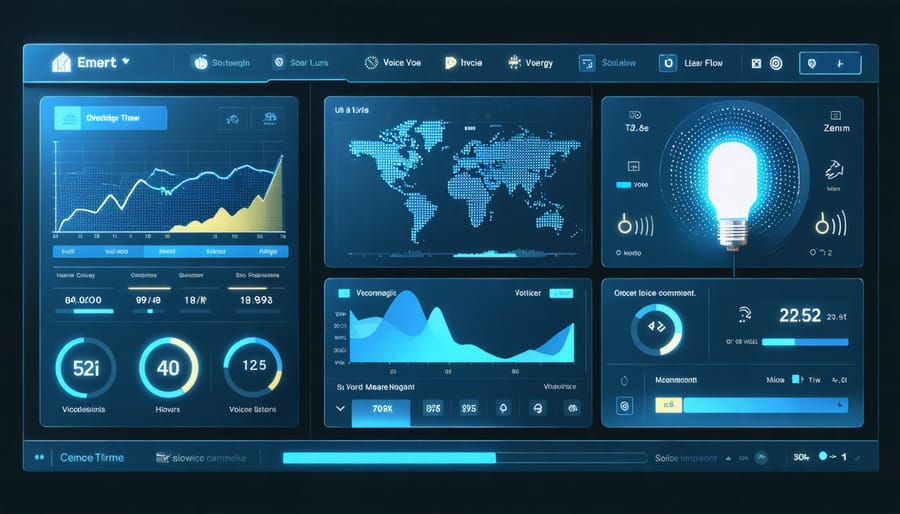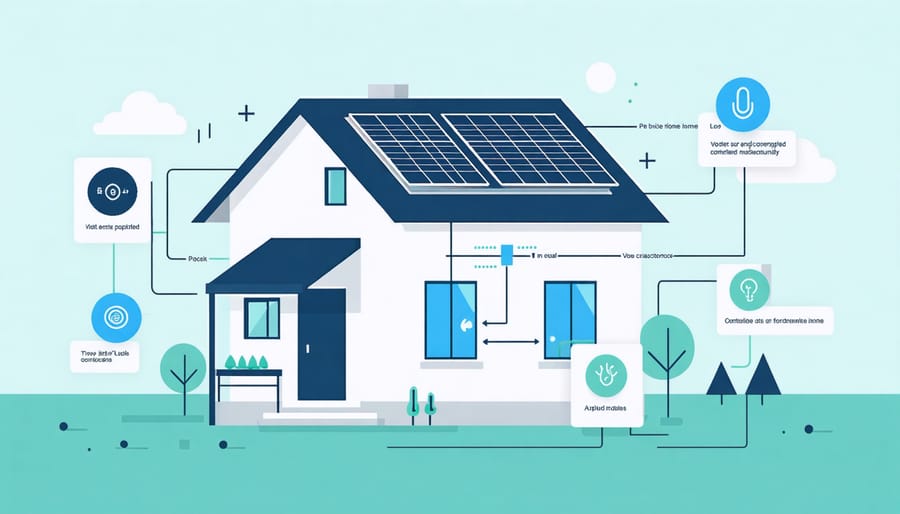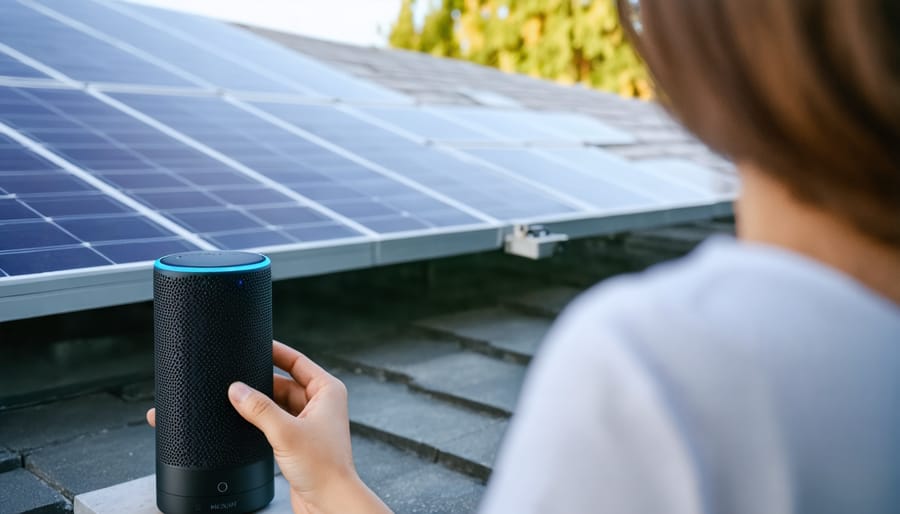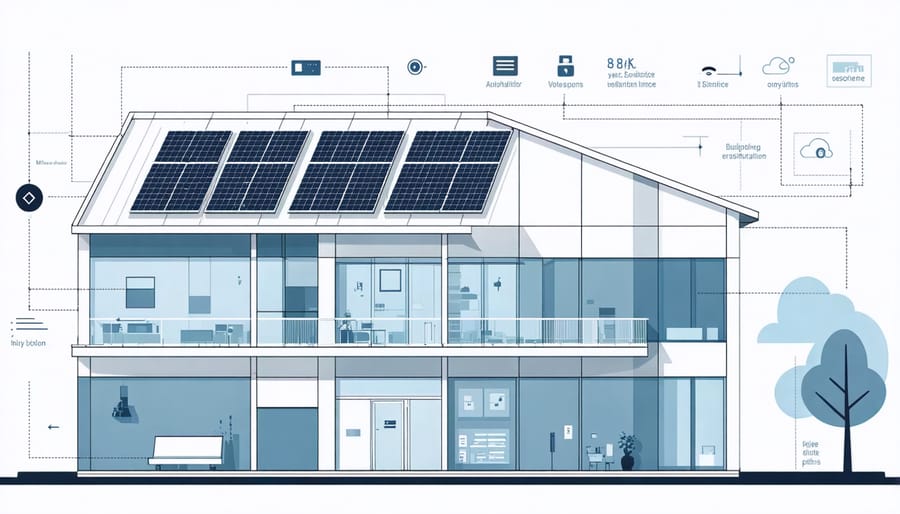Voice Control Makes Solar Energy Management Effortless (Here’s How)

Voice-controlled devices are revolutionizing how we interact with our homes and workplaces, offering unprecedented convenience and efficiency in energy management systems across Europe. From simple commands that adjust lighting to sophisticated algorithms that optimize entire building operations, these intelligent interfaces are becoming the cornerstone of modern automation solutions.
The integration of voice control technology with smart energy systems represents a significant leap forward in sustainable building management. Industry data shows that voice-controlled systems can reduce energy consumption by up to 25% through precise, hands-free control of heating, ventilation, and lighting systems. For European businesses and homeowners, this translates into substantial cost savings while advancing environmental sustainability goals.
As artificial intelligence and natural language processing continue to evolve, voice-controlled devices are becoming increasingly sophisticated, understanding multiple languages, dialects, and complex commands. This technological advancement is particularly relevant in Europe’s multilingual environment, where systems must adapt to diverse linguistic needs while maintaining operational efficiency and security standards.
How Voice-Controlled Energy Management Works
Core Components
Voice-controlled devices in solar energy systems rely on several essential components working in harmony to deliver seamless operation. At the heart of these systems is a voice recognition processor, which converts spoken commands into actionable instructions. This technology works alongside dedicated microphones and speakers, optimised for clear voice capture and feedback in various environmental conditions.
The system’s brain consists of a central control unit that manages communication between voice commands and your solar installation. This interfaces with specialised software that enables smart home integration and handles complex automation routines.
A robust network infrastructure, typically combining Wi-Fi and ethernet connections, ensures reliable communication between components. The setup also includes secure cloud services for processing complex commands and storing user preferences. API integrations connect the voice control system with your solar inverters, battery storage units, and monitoring equipment.
For enhanced functionality, most systems incorporate backup power supplies and fault-detection mechanisms, ensuring continuous operation even during network interruptions. These components are designed to meet strict European safety and compatibility standards while maintaining optimal energy efficiency.

Voice Assistant Integration
Modern voice-controlled devices seamlessly integrate with leading voice assistants to enhance energy management capabilities. Amazon Alexa, Google Assistant, and Apple HomeKit lead the European market, each offering unique features for solar system control and monitoring.
Amazon Alexa excels in energy consumption tracking and automated scheduling, allowing users to create routines for optimal energy usage. Through simple voice commands, users can adjust solar panel angles, monitor real-time energy production, and receive performance reports.
Google Assistant specialises in predictive analytics and smart scheduling, integrating weather forecasts with energy management decisions. Its natural language processing enables intuitive interaction with solar inverters and battery storage systems, making complex operations accessible through conversation.
Apple HomeKit provides robust security features and seamless integration with iOS devices, offering detailed energy visualisations and automated scenes. Its strength lies in creating sophisticated energy-saving routines that respond to household patterns and occupancy.
These assistants support multiple European languages and comply with regional data protection regulations, ensuring accessible and secure energy management for both residential and commercial installations.
Practical Applications in European Homes

Daily Energy Optimization
Voice-controlled devices offer a range of commands that significantly impact energy efficiency in solar-powered homes and businesses. Common energy-optimization commands include “adjust solar panel tilt,” “show energy consumption,” and “activate power-saving mode,” enabling users to fine-tune their system’s performance without manual intervention.
By implementing voice commands like “schedule peak production hours” or “optimize battery charging,” users can maximise their solar energy utilisation during optimal daylight periods. The system can automatically adjust energy distribution based on real-time weather data and consumption patterns, reducing waste and improving overall efficiency.
For commercial applications, advanced commands such as “generate efficiency report” or “balance load distribution” help facility managers monitor and control energy usage across different zones or departments. Voice-activated smart thermostats respond to commands like “set efficient temperature” or “activate night mode,” automatically adjusting heating and cooling systems to maintain optimal energy consumption.
Integration with energy monitoring systems allows users to request instant updates through commands like “report current solar production” or “compare today’s efficiency.” This immediate access to performance data enables quick decision-making and system adjustments, potentially saving up to 15-20% on energy costs.
The convenience of hands-free control encourages more frequent system optimization, as users can easily make adjustments while multitasking or from anywhere within voice range, ensuring their solar installation operates at peak efficiency throughout the day.
Smart Battery Management
Voice control technology has revolutionized how we interact with solar battery systems, offering unprecedented convenience and control over energy management. Through simple voice commands, users can monitor battery levels, adjust charging parameters, and optimize energy consumption patterns in real-time.
Modern smart assistants like Alexa, Google Assistant, and Siri now integrate seamlessly with battery management systems, allowing homeowners to check their storage capacity, initiate backup modes, or switch between grid and battery power using natural language commands. This hands-free control is particularly valuable during power outages or when optimizing energy usage during peak tariff periods.
The system can provide vocal updates on battery health, charging status, and energy consumption patterns, helping users make informed decisions about their power usage. Advanced features include automated scheduling of battery charging during off-peak hours and voice-activated emergency power deployment.
For businesses and industrial applications, voice control offers efficient management of large-scale energy storage systems. Facility managers can quickly respond to demand fluctuations, manage multiple battery units, and ensure optimal performance through simple voice instructions. The technology also supports multilingual commands, making it accessible to diverse user groups across Europe.
Integration with smart home systems enables comprehensive energy management, where voice commands can orchestrate battery usage alongside other household appliances for maximum efficiency and cost savings.

Commercial Implementation Benefits
Energy Cost Reduction
Voice-controlled devices are emerging as powerful tools for sustainable energy management, offering significant cost reductions through intelligent automation and precise control. By enabling hands-free operation of lighting, heating, and cooling systems, these devices help eliminate energy waste from forgotten switches or inefficient temperature settings.
Studies across European businesses show that voice-controlled smart building systems can reduce energy consumption by 15-25% through automated scheduling and real-time adjustments. The technology’s ability to integrate with occupancy sensors and natural light detection ensures optimal energy usage during peak and off-peak hours.
For instance, simple voice commands can activate energy-saving modes during non-operational hours, adjust ventilation based on room occupancy, and fine-tune lighting levels according to natural daylight availability. The system’s continuous learning capabilities also help identify patterns in energy consumption, suggesting improvements for more efficient resource allocation.
These innovations are particularly valuable in large commercial spaces where manual control of multiple systems would be time-consuming and prone to human error, making voice control a practical solution for energy efficiency optimization.
Operational Efficiency
Voice-controlled devices have revolutionised the way we manage energy systems, offering unprecedented operational efficiency through simple verbal commands. By integrating voice control with smart energy management systems, users can effortlessly adjust settings, monitor consumption, and optimise their solar power usage without navigating complex interfaces.
These systems enable quick responses to changing energy needs, allowing users to adjust power distribution, activate energy-saving modes, or modify system settings through natural language commands. For instance, users can request immediate updates on solar production, switch between grid and battery power, or adjust temperature controls with simple voice instructions.
The efficiency gains are particularly notable in commercial settings, where facility managers can control multiple systems simultaneously. Voice commands can trigger pre-set scenarios, such as activating evening power-saving modes across entire buildings or initiating emergency backup procedures during grid fluctuations.
In residential applications, homeowners benefit from streamlined daily routines, using voice commands to schedule appliance usage during peak solar production hours or automate energy-intensive tasks. This hands-free approach not only saves time but also encourages more active engagement with energy management, leading to improved consumption patterns and reduced waste.
Future-Proofing Your Solar Installation
As voice-controlled technology continues to evolve rapidly, ensuring your solar installation remains compatible with future innovations is crucial. Current trends indicate a growing integration between smart home systems and renewable energy management, with voice control becoming increasingly sophisticated in handling complex energy commands and automation scenarios.
To future-proof your installation, consider implementing modular control systems that can be easily updated through software updates rather than hardware replacements. Many leading manufacturers now offer expandable platforms that allow for seamless integration of new features and capabilities as they become available.
Compatibility with major voice assistant platforms like Amazon Alexa, Google Assistant, and Apple HomeKit should be a key consideration. Look for solar monitoring systems and inverters that support open protocols and standard APIs, enabling easier integration with future smart home technologies.
The European Union’s emphasis on standardisation in smart energy systems is driving manufacturers to adopt common protocols, making it easier to upgrade and integrate new voice-control features. When selecting components for your solar installation, verify their compliance with relevant European standards and their ability to accommodate future protocol updates.
Consider investing in smart inverters and energy management systems that offer robust connectivity options and regular firmware updates. This approach ensures your voice-controlled solar system can adapt to emerging energy management trends while maintaining optimal performance and security standards.
Voice-controlled devices have revolutionised how we interact with solar energy systems, making sustainable energy management more accessible and efficient than ever before. By integrating voice commands into solar installations, European homeowners and businesses can monitor and adjust their energy consumption with unprecedented ease and convenience.
The benefits of voice-controlled solar management extend beyond simple convenience. These systems offer enhanced energy efficiency through precise control, real-time monitoring capabilities, and seamless integration with existing smart home ecosystems. For businesses, the technology streamlines operations and reduces the learning curve for staff managing energy systems.
As we progress towards a more sustainable future, voice-controlled solar management represents a significant step forward in making renewable energy more user-friendly and efficient. The technology’s ability to simplify complex energy management tasks while providing detailed insights into consumption patterns makes it an invaluable tool for both residential and commercial applications.
We encourage European solar energy users to embrace this innovative technology, as it not only enhances the user experience but also contributes to more efficient energy management and a greener future. With continuing advancements in voice recognition technology and solar energy systems, the potential for further improvements and applications remains promising.
Leave a Reply